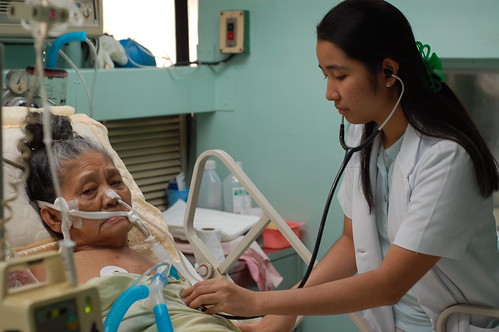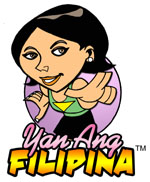 illustration by Sinagtala
illustration by SinagtalaCenturies ago, the babaylan served as seer and sage, healer and community "miracle-worker." They held an important and influential role in pre-Christian Filipino society as the primary mediator between the spirit world and the human world. While the role of a babaylan was open to both male and female, most babaylans from the pre-Hispanic era were female. These women healers were both revered and well-respected, and their value to their community well-recognized.
Today, after a long and arduous struggle, Filipino women in medicine have finally come into their own. Like their babaylan counterparts, the Filipina doctor has once more reclaimed her role in modern Filipino society both as healer and a force to be reckoned with.
As someone who made the decision to become a doctor at a young age, it is hard for me to imagine a time when my having been born a female would have kept this ambition of mine from coming true. While the opportunity to pursue medicine as a career is something that my generation of Filipina doctors take for granted, this was a privilege hard won.
The arrival of the Spanish in the sixteenth century marked the beginning of a long period of repression for Filipino women. Babaylanic practices were ruthlessly suppressed in the onslaught of mass conversion to Christianity. The role and power of the Filipina was much diminished in the male-dominated colonial society. From having equal stake in community matters, they became relegated to secondary citizen status. For over 400 years of Spanish rule, women's options were to either become keepers of home and hearth or devote themselves to a life of service to the Church inside a nunnery.
A similar way of thinking pervaded Western society, the home of modern medicine. Since medicine, like most intellectual pursuits, was considered the bailiwick of men, women penetrated this field against much resistance. In the United States, the birthplace of the Women's Rights movement, women lobbied for admission to medical schools and the right to train beside their male counterparts in the mid-1800's. It was in 1849 that the first woman in the US was given a Doctor of Medicine degree. In the Philippines, it would only be in 1932 when the first Filipino women students were accepted into the University of Santo Tomas - the premiere educational institution established by the Spanish in the Philippines at the time.
The coming of the Americans in 1898 ushered in the winds of change for Filipina women. Powered by the advances in women's rights in the mainland US and in keeping with their policy of capturing the Filipino mind with education, American established institutions opened their doors to Filipino men and women hungry for learning. This included the Philippine Medical School - what would eventually become the U.P. College of Medicine.
It is apt that the rebirth of the Filipina healer tradition came in the form of an obstetrician - a doctor who practices in ushering in new life. Dr. Honoria Acosta-Sison, who graduated from a Pennsylvania medical school in 1910, was the first Filipina doctor and the first Filipina obstetrician. She was soon followed by Dr. Olivia Salamanca, who also studied medicine in Pennsylvania but whose life was cut short by tuberculosis at 24. Dr. Maria Paz-Mendoza Guazon, who was the first woman awarded a Doctor of Medicine by the U.P. College of Medicine in 1912.
Both Dr. Honoria Acosta-Sison and Dr. Maria Paz Mendoza went on to have long, illustrious careers and paved the way for the other brave Filipinas to pursue their dreams of medical glory. By 1930, women comprised 25% of the 404 enrolled medical students at the U.P. College of Medicine. Today, the U.P. College of Medicine accepts an equal number of men and women to its roster of first year students every year. In all medical schools around the country, the number of Filipina women aspiring to become doctors is apace with their male colleagues.
Modern Filipina doctors have come a long way in the span of a few decades. Despite many obstacles, they dared to challenge the daunting odds against them - and won. Like their babaylan counterparts, a good number of them hold influential positions in their communities and are leaders in their own right.
The image of the Filipina doctor as modern-day babaylan is not far-fetched. In ancient Filipino culture, the babaylan is the epitome of balance, as primary mediator of the spirit world and the human world. While modern women are all too often pressured to conform into the stereotypes of domestic nuturers or aggressive career women, the Filipina doctors have transcended these two extremes by being able to be both and to excell in all aspects of their lives at the same time. Apart from being doctors, they play an an integral part of Filipino society as mothers, sisters, daughters, and friends.
Many of these women are now at the helm of their different specialties, standing equal to their male colleagues, and are helping to steer the course of medicine in the Philippines. They can be found in both medical and surgical fields. Some are practicing in law, in politics, in public service, in industry, and in research. They continue to make their mark not only within the country but have also risen to prominence abroad. Their contributions to their fields and their communities are well-recognized, and they are well-respected not only for being accomplished physicians, but also for being compleat women.
As the face of Philippine medicine continues to change, these pioneering Filipina doctors will continue to break perceived boundaries, practice medicine beyond expectations, and set the standards for the next generation - our generation - of Filipina doctors to follow. And while every new trail they blaze is a step forward into the future, for the Filipina healers it is a step closer to closing that circle first drawn by tradition many centuries ago.

My submission for the first edition of The Blog Rounds blog carnival.
This article won First Place in the recently concluded Philippine Encyclopedia Filipina Stories writing project in support of the Filipina Images campaign.
Related Links:
First Filipino Women Physicians
More than Just Being Physicians
Babaylan Rising










14 comments:
Very nice post, Doc. Very apt for a maiden edition of TBR!
Hope I did put "justice" on your eloquent writing! Mine was simply hilarious!
The First ed is up! Visit my blog!
Keep blogging
thanks! :) i just came from there - kudos on a good maiden voyage! hope we can keep this up and generate more posts.
i also put it up on PBS and Filipina images with link back to your blog. :)
Hi!
Nice post!
Sis, I linked your entry to mine. oks po ba :)
Keep Blogging!
nice.
I think Dr. Fe del Mundo could be very well included in the list of many Filipina doctors that contributed greatly to the country. She's well-known not only here in the Philippines but also in the U.S. And imagine, she's still in pedia practice at the age of 94! Whoa! Now that's someone to look up to, as well as the other Filipinas you've mentioned :-)
See an article about her here: http://www.feu-alumni.com/announcements/fdm.htm
I wonder if I could last that long practicing medicine.
Thanks for joining the contest. Please make sure all the links required in number 5 are all in
http://en.wikipilipinas.org/index.php?title=WikiPilipinas:Filipina_Stories
@Prudence: fe del mundo is a medical stateswoman. i would have wanted to add her, kaya lang di ko masingit sa flow. other women worthy of mentioning are dr. aida baltazar, dr. lourdes manahan, dr. herminia cifra, and many more amazing pinay docs. :)
@noemi: the link doesn't work if you click the picture, but the text link on top of the picture is in place. the filipina images is linked to the "yan ang filipina" icon on the sidebar. :)
Congrats for winning First Prize! Truly deserving. I hope you continue to write for the Filipina Images Campaign.
panalo ka mother! gosh... so proud of you!
Congratulations =)
Congratulations!
Congrats! This article tops the WikiPilipinas Filipina Stories contest! :)
I love the way you write... full of historical notes but its really not boring hehhe. Thank you doc for sharing this. Keep it up!
i was googling for images of babaylan and your website came up. thanks for your interest in the babaylan. please check out my book, A Book of Her Own: Words and Images to Honor the Babaylan, on amazon.com. I'm currently writing a sequel on it.
more power to you!
leny strobel
Post a Comment